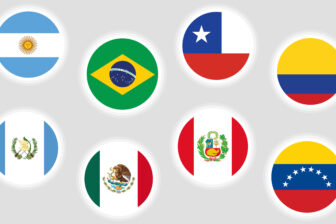If you mainly see the world through the media (or Twitter), today’s Latin America looks more polarized than ever. Recent runoff elections in Peru and Chile were dominated by accusations of communism or fascism. Meanwhile the leaders in Mexico and El Salvador are routinely denouncing their opponents as corrupt and being characterized as authoritarians in the making. But in truth, if one takes the long view, policy differences are not as dramatic as when the region was discussing privatization or expropriation in the 1990s and early 2000s. The big fights today may be more concentrated among elites than voters, whose views generally do not reflect the stark contrasts depicted by the media.
Latin America has long been a region where elites fight amongst each other – both “ideological” polarization of the left-right variety, as well as what one could call “tribal” polarization, characterized by fierce battles where actual policy differences play a secondary role to questions of partisan identity or feeling of my team against yours. The latter type, also recently labelled as “affective polarization” by U.S. political scientists, reflects divides between Liberals and Conservatives in Colombia, the hostility between Aprists and anti-Aprists in Peru or the antagonism between Peronists and anti-Peronists in Argentina, to name a few examples that led to violence and political instability in the 20th century. The more ideological polarization has also been around for a long time, dating back in Venezuela, for example, to the trienio between 1945-1948 (long before Hugo Chávez) and reaching its peak in the 1960s and 1970s, ending in bloody military coups in many countries.

(Getty)
Polarization among elites did moderate somewhat during the 1980s and 1990s as a wave of democratization (coupled with fear of the military’s return) and economic crisis nudged Latin American politicians of many stripes towards market-oriented policies and a certain policy convergence. But this period was something of an exception, as in the 2000s, ideological polarization restarted as leaders sought to take advantage of the resources of the commodity boom to promote economic redistribution, allowing outsiders to build successful electoral coalitions in Venezuela (Hugo Chávez), Ecuador (Rafael Correa) or Bolivia (Evo Morales). Today’s politics, in which virtually anyone left-of-center is labeled a communist by their opponents, is in many ways a throwback to much of the past century.
But what has been happening with actual voters? If we look at LAPOP data from the early 2000s to the current period, voters who self-identify as left-wing have grown in number, generating a slight polarization, but not a dramatic one. Moreover, patterns of ideological polarization of voters do not seem to correspond to electoral outcomes. For example, in Argentina and Peru, fewer voters self-identified as center over time and more choose the left and right of the political spectrum. But this ideological similarity between Argentina and Peruvian voters does not correspond to their electoral behavior despite the compulsory vote in both countries. In the first round of the 2019 Argentinean presidential elections, the two most voted coalitions gathered 88% of the vote, while in the 2021 Peruvian presidential elections the vote was much more fragmented – with the two leading candidates only collecting 32% of the total. Elsewhere, LAPOP data shows similarities in the ideological distribution of voters in Chile and Bolivia, with a continuous majority in the center with smaller contingents in the left and right suggesting slight polarization over the past 20 years . Yet we have perceived Bolivia as polarized during all this period, while Chilean elites’ differences seemed minor until recently.
Hence, it seems that elites and masses are walking different paths with regards to polarization. Indeed, elites seem to be using polarizing strategies to attract electoral support rather than in response to what’s going on in the minds of voters.
Finally, the axis of polarization may be evolving from the traditional divide over redistribution that characterized the region for so long and towards a cultural or moral dimension. The election of Jair Bolsonaro in Brazil can be perceived as a turning point. He built his coalition on anti-petismo (animosity against the Workers’ Party or PT in power from 2003 to 2016). Yet, political scientist Lucio Renno argues he also added a conservative dimension that combined economic and moral issues in consolidating his electoral following in 2018. Looking at LAPOP data on approval for gay marriage (an issue for which we observe a rapid change in public opinion in many democracies) provides some sense of this potential axis of polarization.
Yet, while this question is polarizing, the pattern is not clear. In both Brazil and Chile, the trajectories of left-wing and center voters start diverging from those self-identified as right-wing voters in the 2018 surveys. That is, while support was growing for all groups before, in 2018 it came down for those identified as right-wing, thus, suggesting an increasing polarization on this issue. However, in Argentina and Mexico, the distance between right-wing voters and the rest shows a secular trend of increasing support for same-sex marriage among all groups, even if always lower among right-wing voters. This may be reflecting a process of secularization of social norms regarding sexual orientation with right-wing voters trailing the rest. In other countries, like Peru and Bolivia, we do not observe much change on public views on the topic with support remaining lower than in the other countries for voters of all ideological stripes. Therefore, it is too early to assess whether this new axis will redefine polarization for voters even if it has become a crucial tool for electoral mobilization in some countries.
In conclusion, polarization is not new to the region, and it doesn’t seem substantially worse today than in decades past. The surge in divisive rhetoric we see online and elsewhere may reflect elite strategies more than changes on the views of voters, and it is unclear whether it will be redefined in cultural or moral terms. More importantly, voter unhappiness with their electoral options has resulted in increasing electoral fragmentation in presidential elections, anti-incumbent vote, and declining electoral turnout. Declining support for democracy among younger voters is another warning sign. Polarizing electoral strategies for differentiation from their challengers and for increasing apparent stakes has been one of the responses found by political elites in this difficult electoral environment.









